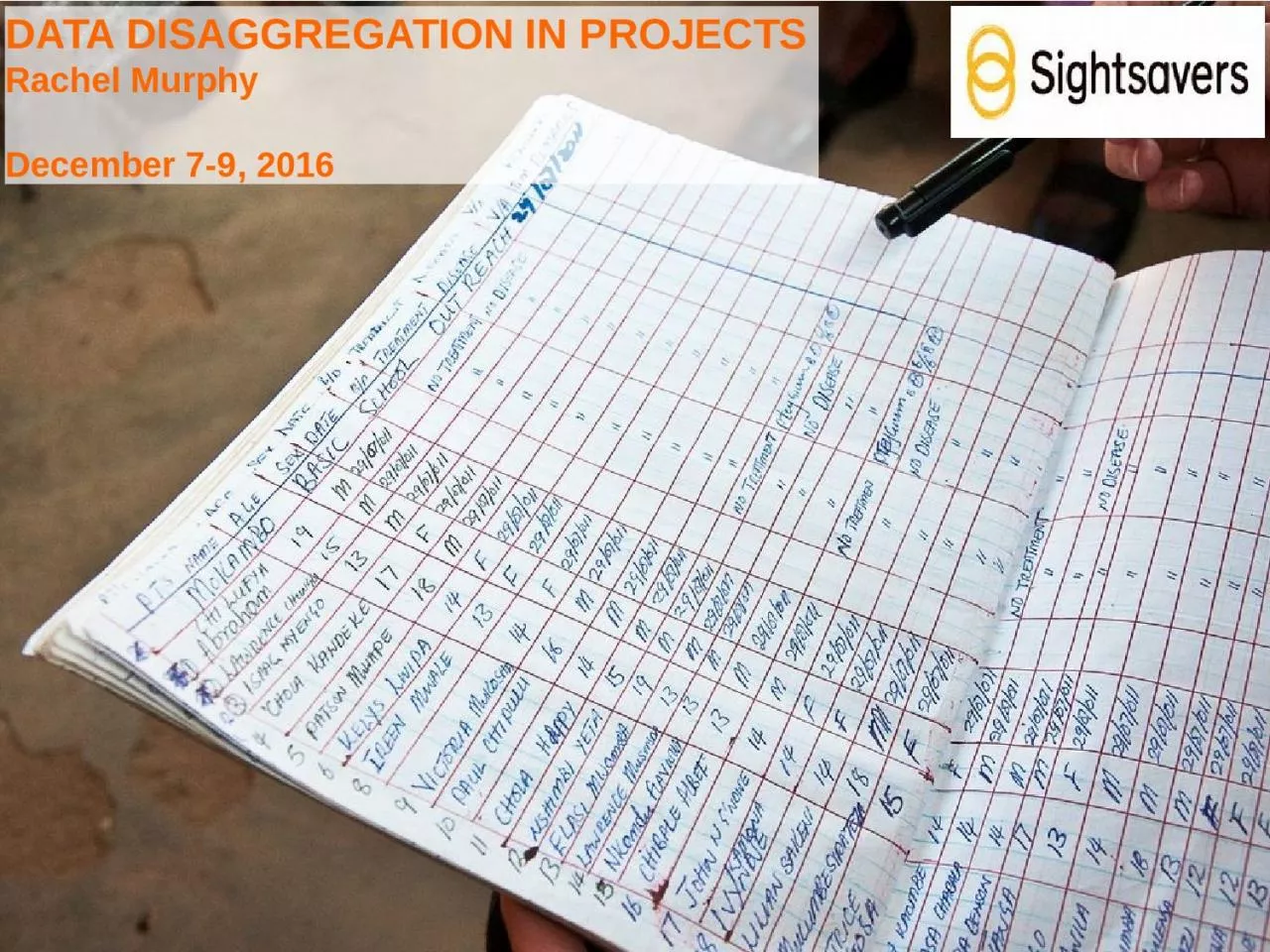

Rachel Murphy December 79 2016 Sightsavers NGO founded in 1950 Our Mission To eliminate avoidable blindness and promote equality of opportunities for people with disabilities ID: 1048517
Download Presentation The PPT/PDF document "DATA DISAGGREGATION IN PROJECTS" is the property of its rightful owner. Permission is granted to download and print the materials on this web site for personal, non-commercial use only, and to display it on your personal computer provided you do not modify the materials and that you retain all copyright notices contained in the materials. By downloading content from our website, you accept the terms of this agreement.
1. DATA DISAGGREGATION IN PROJECTSRachel Murphy December 7-9, 2016
2. SightsaversNGO founded in 1950Our Mission: To eliminate avoidable blindness and promote equality of opportunities for people with disabilitiesThematic areas: Eye health, neglected tropical disease, inclusive education and social inclusion programmes
3. Disability Disaggregation projectThe objectives of this project were to:Understand whether people with disabilities are accessing our servicesBuild the evidence base on how to disaggregate routine data by disability Make Sightsavers projects more inclusive of people with disabilities. Why disaggregate data by disability?Sightsavers’ Empowerment and Inclusion FrameworkSustainable Development Goals & ‘Leaving no one behind’Goal 17: Revitalize the global partnership for sustainable developmentTo influence others with evidence e.g. NGOs, donor agencies
4. MethodsIntegrated WG Short Set of Questions into routine data collection systems to understand the disability status of patients attending our programmes (Africa and Asia)Analysed disability data (descriptive, univariate and multivariate associations between the variables) and developed reportsAs part of this pilot we also collected data on:Experiences of people involved in the project (qualitative)Quality of the data
5. Bhopal District, Madhya Pradesh StateIndia Integrated WGSS and the India census question on disability into Urban Eye Health programme 24,518 patients over a 16 month period attended 3 Vision & Optic centresOutreach CampsOne NGO Eye Health Hospital
6. TanzaniaIntegrated WGSS into data collection at Trachoma Trichiasis (TT) campsIntegrated approach to Neglected Tropical Disease (NTD) elimination 1,439 patients asked over 4 monthsCompared the data with 2008 disability survey Songea district, Ruvuma region
7. Cameroon Integrated WGSS into Rapid Assessment of Avoidable Blindness (RAAB)Data collected on 3,567 patients over a 3 month periodFundong, North-West District
8. MalawiIntegrated WGSS and Equity Tool into data collection systems at TT camps545 patients asked over 6 daysCompared the data with Equity Tool national quintiles (disability data not currently available)Kasungu DistrictKaronga District
9. India – Results 17.5% reported disability (a lot or cannot do at all in at least one domain). 9% when we exclude the sight domain. 0.6% when we ask them directly if they are ‘disabled’
10. VariableValuesWG a lot or worseWG a lot or worse (excluding seeing)Are you disabled? Odds ratioSexMale---Female1.4***2.1***0.7* Age - binary<50---50+3.4***3.3***1.7** LocationHospital---Primary centre8.2***42.5***5.5**** p-value < 0.05 ** p-value < 0.01***p-value < 0.001Univariate associations with disability measuresIndia – Results
11. Tanzania – Results
12. Tanzania - Results
13. Cameroon - Results
14. Malawi - Results
15. Key lessons learned Disability is a concept highly dependant on contextual and cultural factorsEmphasis on sensitisation/training & translationData collection systems can be resistant to changeIntegrate in existing tools & processBuy-in & Ownership Equip all stakeholders with necessary knowledge & toolsData collection itself has a transformative effectEssential as an integral part of an inclusive health programmeNeed to be followed by inclusive health strategies
16. Next StepsContinue to gather learningPilot project in Ghana (Mass Drug Administration)Continue to collect data as part of ‘Inclusive Eye Health Projects’Link disability data with other variables (e.g. equity tool)Looking at piloting the WG/UNICEF Child Functioning Module Use the disability data collected to inform our programmes Share learning with civil societies and NSOPublish reports & policy brief with clear recommendationsWeb page on the project: www.sightsavers.org/everybodycounts Influence the international agenda:Expert Group on data disaggregationPresentation at international conferences Support the implementation of the 2030 Agenda
17. For more information please contact: rmurphy@sightsavers.org